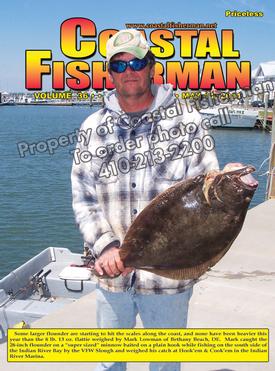


Article by Capt. Mark Sampson
 For a long time, most tournament directors relied solely on the weight of dead fish at the dock to determine the winners of their event. But today, as more and more fishermen recognize the need for, and benefits of, catch-and-release fishing, many tournament directors are responding by increasing
For a long time, most tournament directors relied solely on the weight of dead fish at the dock to determine the winners of their event. But today, as more and more fishermen recognize the need for, and benefits of, catch-and-release fishing, many tournament directors are responding by increasing
the emphasis on release categories in their events. But properly running a release tournament, or even just a release division, is no easy task.
In conventional tournaments, determining who wins is usually as simple as seeing who brings the biggest fish to the docks. But for a release division where no physical evidence of the fish will be brought in, there needs to be rules and procedures to ensure the validity of each catch. Understandably, winners need to be properly verified just as losers need to be assured that they lost fairly.
Equally important is the need for anglers who engage in catch-and-release fishing (tournament or not) do so with due regard to the survivability of their catch - there’s not much point in releasing a fish that’s going to die anyway! This is particularly true in tournaments that result in a sudden increase in the amount of fishermen targeting species of fish that might already be highly pressured from other sources. Since tournament anglers will likely be fishing at the top of their game with a higher level of proficiency and a stronger incentive to catch as many fish as possible in a limited time than they would if they were just out for a casual fishing trip with friends and family, it’s probably safe to say that the catch-and-release rates per average angler go up during tournaments and, therefore, the need for proper release techniques is never more important.
With all this in mind, on Saturday May 21st, myself and the other directors of the 31st Annual Ocean City Shark Tournament will be conducting a Shark Release Clinic on the docks at the Ocean City Fishing Center from 4 pm to 7 pm. The three-hour event will give the public the opportunity to learn first-hand how to fish for and handle sharks in a manor that’s safe for both fish and fisherman. During the clinic we’ll review the rigging and use of circle hooks, fighting techniques, tagging, in-water measuring, de-hooking, photographing and identification of sharks. We’ll also take the opportunity to discuss and answer questions about tournament rules and procedures.
Whether they’re fishing a tournament or not, anglers should keep in mind that despite the hype, shark fishing is really no more dangerous to anglers than any other types of big-game offshore fishing, as long as they remember Common Sense Rule #1:?“stay in the boat!” The inherent hazards of dealing with any very large fish at the side of a boat cannot be ignored. Whether it’s a blue marlin, big tuna, or a big mako, when you’re holding the leader and playing tug-o-war with a few hundred pounds of upset fish from a slippery and rolling deck it can get dicey, and occasionally fishermen are suddenly surprised to find that they have quite unintentionally broken that first rule. While a requirement to stay in the boat has not been adopted as an official OC Shark Tournament rule, at the Release Clinic we’ll discuss how anglers safely can work with sharks and avoid any unintended bites, bruises, or baths.
Since fishermen release far more sharks than they actually bring back to the dock, it’s important that the animals they send home have the chance to swim away with the best chance for survival. Overall, sharks are pretty tough critters, but like any fish, they can succumb to excessive stress and trauma if proper release techniques aren’t followed. Anglers have to keep in mind that just because they see a fish swim away doesn’t guarantee it survived the encounter unscathed. At the Release Clinic we’ll discuss and demonstrate techniques, and the proper use of tackle and tools that will increase the odds of survival of the fish they turn loose.
The big news this year is that the Guy Harvey Ocean Foundation has signed on as a major sponsor of the OC Shark Tournament Release Division. Through his foundation’s involvement, Guy Harvey hopes to provide an increased level of shark conservation while demonstrating to the fishing industry that release tournaments with large cash payouts can be both successful as well as a wise alternative to traditional events that result in dead fish being brought back to the scales. To help achieve their goal, the GHOF is providing funds that will more than double the Release Division’s guaranteed cash payouts, as well as prize packages for top release point winners.
With some new Release Division categories and so much money up for grabs, we’ve obviously had to tweak tournament rules and procedures to ensure that everything runs smoothly and fairly. These new rules will be discussed at the Release Clinic.
With the Release Clinic happening May 21st and the actual Ocean City Shark Tournament not kicking off until June 15th, anglers will have plenty of time to hone their skills and practice newfound techniques so they’ll be in top form for the competition and the rest of the fishing season.
Captain Mark Sampson is an outdoor writer and captain of the charter boat “Fish Finder”, docked at the Ocean City Fishing Center.